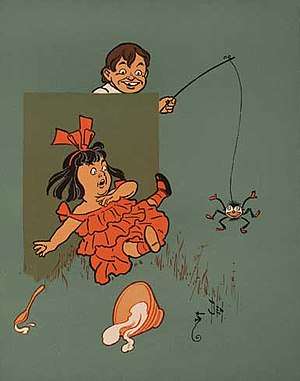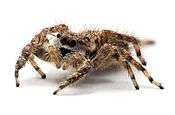Arachnophobia
Arachnophobia is an intense and irrational fear of spiders and other arachnids such as scorpions.[3]
| Arachnophobia | |
|---|---|
| Other names | Arachnephobia[1] |
 | |
| Though many arachnids are harmless, a person with arachnophobia may still panic or feel uneasy around one. Sometimes, even an object resembling a spider can trigger a panic attack in an arachnophobic individual. The above cartoon is a depiction of the nursery rhyme "Little Miss Muffet," in which the title character is "frightened away" by a spider. | |
| Pronunciation |
|
| Specialty | Psychiatry |
| Treatment | Exposure therapy[2] |
Treatment is typically by exposure therapy, where the person is presented with pictures of spiders or the spiders themselves.[2]
Signs and symptoms
People with arachnophobia tend to feel uneasy in any area they believe could harbor spiders or that has visible signs of their presence, such as webs. If arachnophobes see a spider, they may not enter the general vicinity until they have overcome the panic attack that is often associated with their phobia. Some people run away, scream, cry, have emotional outbursts, experience trouble breathing, sweat, have increased heart rates, or even faint when they come in contact with an area near spiders or their webs. In some extreme cases, even a picture or a realistic drawing of a spider can trigger intense fear.
Reasons
Arachnophobia may be an exaggerated form of an instinctive response that helped early humans to survive[4] or a cultural phenomenon that is most common in predominantly European societies.[5]
Evolutionary
An evolutionary reason for the phobia remains unresolved. One view, especially held in evolutionary psychology, is that the presence of venomous spiders led to the evolution of a fear of spiders, or made acquisition of a fear of spiders especially easy. Like all traits, there is variability in the intensity of fear of spiders, and those with more intense fears are classified as phobic. Being relatively small, spiders do not fit the usual criterion for a threat in the animal kingdom where size is a factor, but they can have medically significant venom. However, a phobia is an irrational fear as opposed to a rational fear.[6]
By ensuring that their surroundings were free from spiders, arachnophobes would have had a reduced risk of being bitten in ancestral environments, giving them a slight advantage over non-arachnophobes in terms of survival. However, having a disproportionate fear of spiders in comparison to other, potentially dangerous creatures[7] present during Homo sapiens' environment of evolutionary adaptiveness may have had drawbacks.
In The Handbook of the Emotions (1993), psychologist Arne Öhman studied pairing an unconditioned stimulus with evolutionarily-relevant fear-response neutral stimuli (snakes and spiders) versus evolutionarily-irrelevant fear-response neutral stimuli (mushrooms, flowers, and physical representation of polyhedra) on human subjects and found that ophidiophobia and arachnophobia required only one pairing to develop a conditioned response while mycophobia, anthophobia, and phobias of physical representations of polyhedra required multiple pairings and went extinct without continued conditioning while the conditioned ophidiophobia and arachnophobia were permanent.[8] Psychiatrists Isaac Marks and Randolph M. Nesse and evolutionary biologist George C. Williams have noted that people with systematically deficient responses to various adaptive phobias (e.g. arachnophobia, ophidiophobia, basophobia) are more temperamentally careless and more likely to end up in potentially fatal accidents and have proposed that such deficient phobia should be classified as "hypophobia" due to its selfish genetic consequences.[9][10][11]
A 2001 study found that people could detect images of spiders among images of flowers and mushrooms more quickly than they could detect images of flowers or mushrooms among images of spiders. The researchers suggested that this was because fast response to spiders was more relevant to human evolution.[12]
Cultural
The alternative view is that the dangers, such as from spiders, are overrated and not sufficient to influence evolution. Instead, inheriting phobias would have restrictive and debilitating effects upon survival, rather than being an aid. For some communities such as in Papua New Guinea and Cambodia spiders are included in traditional foods. This suggests arachnophobia may be a cultural, rather than genetic trait.[13][14]
Treatments
The fear of spiders can be treated by any of the general techniques suggested for specific phobias. The first line of treatment is systematic desensitization – also known as exposure therapy.[2] Before engaging in systematic desensitization, it is common to train the individual with arachnophobia in relaxation techniques, which will help keep the patient calm. Systematic desensitization can be done in vivo (with live spiders) or by getting the individual to imagine situations involving spiders, then modelling interaction with spiders for the person affected and eventually interacting with real spiders. This technique can be effective in just one session, although it generally takes more time.[15]
Recent advances in technology have enabled the use of virtual or augmented reality spiders for use in therapy. These techniques have proven to be effective.[16] It has been suggested that exposure to short clips from the Spider-Man movies may help to reduce an individual's arachnophobia.[17]
Epidemiology
Arachnophobia affects 3.5 to 6.1 percent of the global population.[18]
See also
- Arachnophobia (film)
- Apiphobia (fear of bees)
- Entomophobia (fear of insects)
- Myrmecophobia (fear of ants)
- Zoophobia (fear of animals)
References
- Patricia Bowen (ed.), Internal Medicine Words, Rayve Productions, 1997, p. 18.
- Sperry, Len (2015). Mental Health and Mental Disorders: An Encyclopedia of Conditions, Treatments, and Well-Being [3 volumes]: An Encyclopedia of Conditions, Treatments, and Well-Being. ABC-CLIO. p. 430. ISBN 9781440803833.
- Heather Hatfield. "The Fear Factor: Phobias". Webmd.com
- Friedenberg, J.; Silverman, G. (2005). Cognitive Science: An Introduction to the Study of Mind. SAGE. pp. 244–245. ISBN 1-4129-2568-1. Retrieved 2008-10-11.
- Davey, G.C.L. (1994). "The "Disgusting" Spider: The Role of Disease and Illness in the Perpetuation of Fear of Spiders". Society and Animals. 2 (1): 17–25. doi:10.1163/156853094X00045.
- https://www.webmd.com/anxiety-panic/features/fear-factor-phobias#1
- Gerdes, Antje B.M.; Uhl, Gabriele; Alpers, Georg W. (2009). "Spiders are special: fear and disgust evoked by pictures of arthropods" (PDF). Evolution and Human Behavior. 30: 66–73. doi:10.1016/j.evolhumbehav.2008.08.005.
- Öhman, Arne (1993). "Fear and anxiety as emotional phenomena: Clinical phenomenology, evolutionary perspectives, and information-processing mechanisms". In Lewis, Michael; Haviland, Jeannette M. (eds.). The Handbook of the Emotions (1st ed.). New York: Guilford Press. pp. 511–536. ISBN 978-0898629880.
- Nesse, Randolph; Williams, George C. (1994). Why We Get Sick: The New Science of Darwinian Medicine. New York: Vintage Books. pp. 212–214. ISBN 978-0679746744.
- Nesse, Randolph M. (2005). "32. Evolutionary Psychology and Mental Health". In Buss, David M. (ed.). The Handbook of Evolutionary Psychology (1st ed.). Hoboken, NJ: Wiley. pp. 911–913. ISBN 978-0471264033.
- Nesse, Randolph (2019). Good Reasons for Bad Feelings: Insights from the Frontier of Evolutionary Psychiatry. Dutton. pp. 64–76. ISBN 978-1101985663.
- Öhman, A., Flykt, A., & Esteves, F. (2001). "Emotion drives attention: Detecting the snake in the grass". Journal of Experimental Psychology: 130 (3), 466–478.
- Wagener, Alexandra L.; Zettle, Robert D. (2011). "Targeting Fear of Spiders With Control-, Acceptance-, and Information-Based Approaches" (PDF). The Psychological Record. 61 (1). Archived from the original (PDF) on 2011-06-14.
- Ohman, A; Mineka, S (2001). "Fears, Phobias, and Preparedness: Toward an Evolved Module of Fear and Fear Learning" (PDF). Psychological Review. 108 (3): 483–522. doi:10.1037/0033-295X.108.3.483. PMID 11488376.
- Ost, L. G. (1989). "One-session treatment for specific phobias". Behaviour Research and Therapy. 27 (1): 1–7. doi:10.1016/0005-7967(89)90113-7. PMID 2914000.
- Bouchard, S.; Côté, S.; St-Jacques, J.; Robillard, G.; Renaud, P. (2006). "Effectiveness of virtual reality exposure in the treatment of arachnophobia using 3D games". Technology and Healthcare. 14 (1): 19–27.
- Gabe Friedman (April 25, 2019). "Israeli Researchers: "Spider Man" movies decrease Spider Phobia". Arutz Sheva. Retrieved April 25, 2019.
- Schmitt, WJ; Müri, RM (2009). "Neurobiologie der Spinnenphobie". Schweizer Archiv für Neurologie. 160 (8): 352–355. Archived from the original on 23 August 2016.
External links
| Classification |
|---|
- Stiemerling, D. (1973). "Analysis of a spider and monster phobia". Z Psychosom Med Psychoanal (in German). 19 (4): 327–45. PMID 4129447.
- National Geographic: "Fear of Snakes, Spiders Rooted in Evolution, Study Finds"
